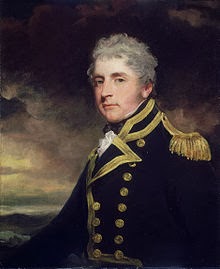The Euryalus was a 36-gun frigate commanded by Captain Henry Blackwood. Nelson had his small frigate squadron stationed outside Cadiz to keep an eye on the combined French and Spanish fleet sheltering within, and they used a chain of signals to keep in constant communication with him so he could keep the bulk of his fleet out of sight of the enemy. So as soon as the enemy began to move to sea, Nelson knew about it. Nelson had missed the French more than once during his career because a lack of frigates, which he called his 'eyes'. But this time, they would not be able to escape him.
Frigates were too small to take part in major fleet actions against ships with 74 guns or more, but they played a role in boarding surrendered ships, towing disabled ships out of action and, crucially, passing along signals. As such, the Euryalus observed much of the battle and so her logbook reads as an interesting first-hand overview of it.
 | |
| Captain Henry Blackwood of the Euryalus |
The Log of the Euryalus: Sunday, 20th October 1805
P.M. - Heavy rain and thick weather. At 12.30, the weather clearing up a little, saw the enemy to leeward under low sail on the larboard tack; being close wore ship, reefed topsails and made all possible sail to look out for the English fleet in the SSW. Still keeping sight of the enemy. At 1, more moderate; out reefs, set topgallant sails. Saw the Sirius to leeward of us and recalled her. At 2, saw the English fleet in the SSW, standing to the westward. At 2.10, made a telegraph message to the Sirius, 'I am going to the Admiral, but will return before night.' At 3, exchanged ship's numbers with the fleet. At 3.20, made the telegraph message, 'The enemy seems determined to push to the westward, with numeral pendant 30 N by E,' which the Admiral answered. Saw an English line-of-battle ship to leeward of the fleet with her main topmast down. At 4, wore ship and stood to the northward. At 4.40, the English fleet wore. Enemy's fleet on the larboard tack to the northward. Up mainsail, crossed the royal yards. At 5.20, observed some of the enemy's look-out ships reconnoitring us; tacked ship. At 5.40, answered the Admiral's signal, 'I rely on your keeping sight of the enemy.' At 6, ditto weather. Victory and fleet to the southward. Enemy's fleet and Sirius N by E. Made several lights and burnt false fires to show the enemy's position to Lord Nelson and the fleet. At 8.30, wore ship. At 9.50, wore ship. Up mainsail and kept upon the enemy's weather beam, about 2 or 3 miles. Made and shortened sail occasionally. Fired guns and burned false fires as necessary. At 12, moderate breezes. The body of the enemy's fleet SE by S about 3 miles, and the light of the English fleet to the southward and westward 5 or 6 miles.
More to come..

No comments:
Post a Comment